Today I want to talk about the back extension exercise, which I often is not always include in workouts. Yes, other movements such as the Romanian Deadlift work the low back but it is mostly isometrically. That is, there is no movement in the low back. Or there shouldn’t be. The back extension complements the movement by training the spinal erectors dynamically.
From a safety standpoint, I think there is benefit to working the spinal erectors through full flexion and extension since there are times when the back simply can’t be kept flat. Low back strengthening can also benefit squats and deads simply by ensuring that they aren’t a weak point in the movement. That’s in addition to any safety benefits.
The simple fact is that heavy squats and deadlifts can often go awry during maximal or near maximal sets, folks lose form no matter how hard they try not to; this often involves rounding of the upper or lower back or both. And if the low back hasn’t been trained in such a way to handle those stresses in a rounded position, injury often results.
As well, some recent research, primarily from Stuart McGill’s lab, has tied low back pain to endurance in the spinal erectors. While there are certainly other ways to do it, dynamic back extensions are one way to train this capacity.
Muscles Trained in the Back Extension
As the name suggests and the introduction states, the primary focus of back extensions is, of course, the lower back musculature, specifically the spinal erectors. As well, depending on the specifics of how the exercise is done, many other muscles are often hit.
When weight is used, the upper back receives a training effect (in the midback/scapular retractors). As well, the hamstrings and glutes will be hit (either dynamically or isometrically) depending on the specifics of the type of back extension chosen.
Back Extension Technique
.Fundamentally, there are a few different ways to do back extensions, depending on what the goal is. In many ways, this is not unlike the situation with Romanian vs. Stiff Legged Deadlifts.
For now I’m going to ignore what’s happening in the upper back (I’ll come back to that below) and focus only on the spinal erectors, hamstrings and glutes. Now, pretty much any back extension is going to work those muscles to some degree although how the movement is done will affect whether the muscles are hit dynamically or isometrically. The determinant of whether the glutes/hamstrings are worked dynamically or isometrically is primarily determined by where the hip is positioned relative to the edge of the pad.
And there are two options, shown in the pictures below. On the left, you can see that the top of the pelvis is above the top of the pad, this allows the pelvis to rotate during the movement which means that the glutes/hams will be hit dynamically. On the right, the pelvis is set below the top of the pad; this locks the pelvis into place and the glutes/hams will be hit isometrically instead.
.
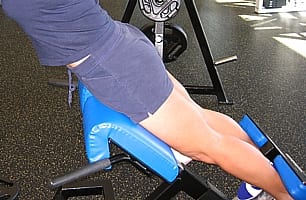

Now, with the pad below the level of the hips, the pelvis is free to rotate. Due to this, there are two options as to what the low back can do: it can round or stay flat. I’ve shown the bottom position of the low pad back extension below. On the left, the low back is rounded at the bottom, on the right, the low back is kept flat.
.
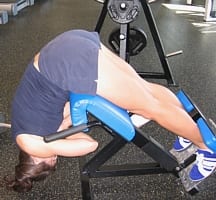

The difference between these two is that rounding the back (along with the pelvis rotating) will hit the spinal erectors, glutes and hamstrings all dynamically. In contrast, with a flat back, the low back will be worked isometrically with the glutes and hamstrings performing hip extension (this is basically like a machine Romanian deadlift).
Now, with the pad high enough to lock the hips, there is only one option and that’s to round the low back. The start and finish position of this is shown below. This will work the spinal erectors dynamically and the glutes/hamstrings isometrically.
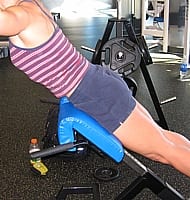

I’d note that since I generally use the back extension specifically to train the spinal erectors dynamically, I can’t say that I use the low-pad, flat backed version very often (if at all). So the issue really becomes one of what I want the glutes or hamstrings to do (which usually depends on what was done earlier in the workout).
If the glutes/hams have already been worked hard (with the Romanian Deadlift or a clean grip deadlift) , I’ll usually lock the hips and localize the stress to working the spinal erectors dynamically. If, for whatever reason, I want some dynamic work for the hamstrings/glutes, I’ll set the pad low and let the hip rotate.
Since the above can get a bit confusing, let me sum up before moving on to other aspects of the exercise. Basically, we have two pad positions (above and below the top of the pelvis) and two possibilities with what the low back does (round at the bottom or stay flat) although there are only actually 3 combinations. Those combinations, along with what they do is shown below.
- Low pad position +rounded back = spinal erectors, glutes, hams all worked dynamically
- Low pad + flat back = spinal erectors worked isometrically, hams/glutes worked dynamically
- High pad + rounded back = spinal erectors worked dynamically, glutes/hams isometrically
- High pad + flat back = can’t be done through any meaningful range of motion
Before moving on, I want to show a proper versus improper top position. Despite the exercise often being called a “hyperextension”, it’s incorrect and dangerous to actually take the spine into hyperextension. You should only extend up until the spine is in a neutral position.
Going higher than this provides no further training effect for the muscles but puts rather enormous strain on the spine itself. Normal spinal extension and spinal hyperextension are shown below (normal on the left, hyperextension on the right). Don’t do what’s on the right.
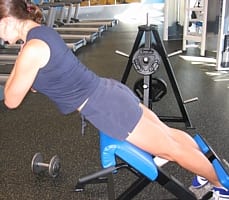

Loading the Back Extension
.The next topic I want to discuss is how to load the movement to increase resistance. Now, without using weight, there are 4 progressively more difficult ways to do back extensions, shown below. In order from easiest to most difficult these are: hands by sides, hands at chest, hands at temples, and hands in the Y position (this has the added advantage of working Traps III/IV). These are shown below.
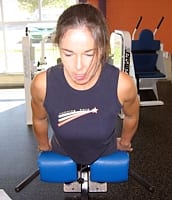
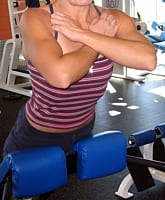
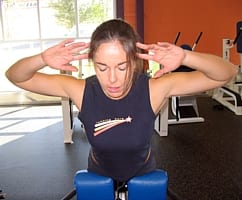
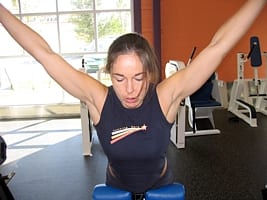
For the most part, I don’t typically use hands at head or hands overhead unless, for some reason, additional weight can’t be added. After someone can do hands at chest easily, I’d rather just start having them add weight to the movement. There are several ways to do this although I’m only going to show two below.
The next way to load the movement is to hold either a plate or dumbbell at chest level (some will also load the movement with a bar held behind the head, this isn’t shown). Both are shown below. One problem with plates is making intermediate jumps. So, for example, once a 25 lb plate becomes too easy, moving to 30 is a pain because you have to try to hold a 25 and 5 lb plate.
I generally prefer dumbbells for this reason. Another benefit to holding weight is that the upper back can be trained as well by ensuring that your shoulder blades are pulled back hard while you hold the weight.
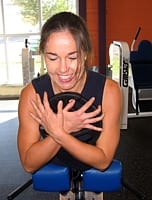

Of course, there are other ways that this movement can be loaded . A weighted vest can be worn and this avoids problems with fatigue from holding heavy dumbbells or plates (it also saves hassle of getting them into position). A recent trend is to attach a rubber stretch band to the bottom of the back extension bench and then attach it around the neck or upper back; this gives a very different loading curve than using a plate or dumbbell due to the stretching of the band. Of course, methods can be mixed as needed or desired.
The One-Legged Back Extension
As a final variant on this movement, a single leg extension can be done by simply taking one leg out from underneath the pads. This makes the movement considerably harder and adds a stabilization component around the pelvis.
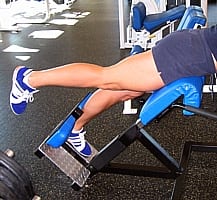
Horizontal vs. 45 Degree Back Extension
Of course, the 45 degree back extension is not the only machine available. Many gyms have a horizontal bench (the gym we shot the above pictures at did not) which I’ve shown below. Many gyms have a true glute-ham raise which can also be used to do straight back extensions.
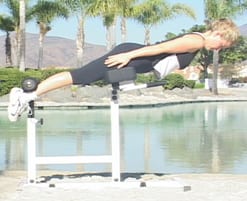
Every issue discussed above for the 45 degree bench is identical here. You can set up so that the pelvis is in front or behind the pad and the same issues with regards to rounding the low back or not all apply. The same goes for the issue of not hyperextending at the top of the movement. The horizontal back extension is generally much more difficult with the position of maximum loading occurring at the top, compared to the 45 degree version which has peak loading when the torso is parallel with the floor.
I’d note that even the 45 degree extension bench can often be too difficult for beginners. I have sometime started complete beginners on a leg curl machine where they can perform a short range back extension using the angle of the pad. Simply pin the weight stack above anything they could possibly leg curl and they can do back extensions until they develop sufficient strength and/or endurance to move to the 45 degree bench.
I’d finish by noting that I no longer do back extensions with trainees lying flat on the floor. Back researcher Stuart McGill has shown that hyperextensions on the floor generate a tremendous amount of disk pressure as they force the body into spinal hyperextension.
Programming the Back Extension
In terms of programming the back extension, there are, as always, many options. Both strength, low back power and muscular endurance can be targeted depending on the specifics of what’s done. As I mentioned in the introduction, low back endurance seems to be related to low-back pain and high rep sets with an isometric hold at the top (ranging from 2-6 seconds) can be beneficial for this.
Athletes who need more strength or power than endurance per se may want to keep the reps lower and weights heavier. A combination of methods (e.g. heavy sets of 5 with a 2 second hold at the top) can achieve some of the best of both worlds.
In general, I tend to put back extensions at the end of a workout, often/usually in conjunction with ab work; the movements can be alternate supersetted to save time. I’d only note that, in my experience, fatigue from low back work can often make abdominal work painful, especially in beginner trainees.
If trainees report low back discomfort during abdominal work, it may be better to save low-back work until the very end of the workout. I also know some trainees who use light low back extensions to warm-up the low back before heavier work but this is something that should be saved for more advanced trainees.
Reps and sets, as noted, can vary massively. A beginner may only perform a single set of low reps in their first few workouts; the low-back is often notoriously weak in the general public and having them do too much initially tends to cause a lot of problems.
With beginning clients, they might only do 1 set of 5-8 at their first workout, even if they felt like they could do more. If there was back pain the following day, I know even that was too much. If not, I’d have them add a couple of repetitions at the next workout. When they got to 12 easily, they’d move to a slightly harder variant (changing hand position, etc) or add a second set.
Finally, I’d note that it’s always better to err on the side of too little than too much with low back work. Taking direct low-back work even close to failure can be a recipe for disaster, it only takes a minor mistake to really ruin someone’s day. Better, in my experience, to keep several reps in the tank and make it up with more sets or whatever. There are exceptions, high level athletes who may need to push closer to failure to prepare themselves for the specific demands of their sport. But save that for folks with more training experience.
Similar Posts:
- Romanian Deadlift vs. Stiff Legged Deadlift
- Cable Row Technique
- Split Squat Technique
- Clean Style Deadlift Technique
- Lat Pulldown Technique
Lyle,
Do you ever use variations that overload the eccentric, such as holding a dumbbell at the chest (as you pictured) for the concentric and holding it at arms length on the eccentric?
Also, do you see any value in holding 1 dumbbell in the finished position of a row and adding an anti-rotation component? The single-leg version yo depicted would definitely require an anti-rotation component at the torso as well as at the hip, whereas the dumbbell held off to one side would seem to concentrate the stress more on the torso resisting rotation with far lass of an anti-rotation component at the hip than the single-leg version.
Nice. Something that rarely gets addressed. Lately I’ve been doing this progression: Glute Ham Raise-Hip Extension (Pad Below Pelvis)-Back Extension (Pad Above Pelvis). I perform each exercise for reps until form begins to break down, then I raise the pad height and continue on with the next in the series.
one more variant… zercher extensions (where you hold a (EZ-) bar in the crook of your elbows)
What about the machines where you sit upright, lean a bit forward and then push the weight back with your back?
Heidi: I am no longer a fan. McGill has done work showing that the starting position of such movements is incredibly hard on the spine. Most machines start you in a horrible position in terms of mechanical advantage. So I stick with the movements discussed in this article.
Lyle,
Would the repeated spinal flexion described to train the lower back dynamically be too great a risk for someone with a history of disc prolapse? Or would mild flexion benefit the issue by increasing stability?
Thanks, Josh
You’ll need to find someone with more injury/rehab experience than I’ve got to answer that one.
Great article, as usual! I’ve been doing back extensions with my low back rounded since I read this article, also adding resistance with a rubber band. It feels good and I have been adding reps. Now, since the movement is loaded and the low back is rounded I fear there could be some risk of disk compression injury. Thus I am a bit reluctant to add too much wight. Still I want to progress… The question is: do you have a general idea of how much weight you can use in this exercise; what would be “normal”, “advanced” etc.? Regards Fredrik
The portion of the back extension that is maximally loaded occurs when the spine is in neutral, hence it’s not a combination of compression/spinal flexion. And when the spine is rounded (at the bottom), the resistance is primarily causing distraction forces (the opposite of compression). So I don’t consider it an issue.
Hey Lyle, great article, as I have been looking for information specifically on proper back extension technique for a while now and have always been confused as to what muscles should be working during this exercise. I would like some clarification on the rounded back aspect of the movement. I think I understand what you’re saying (but could not be) about the part of the movement where the spine is rounded not being subject to compressive forces (which is dangerous, ie rounded back during a squat). I can see a distinct difference in where the force of the weight is going. But then I wonder why it is always advised that a person not round one’s back during a deadlifting movement? The trajectory of force on the weight of a deadlift seems similar to the bottom position of a hyperextension (weight below you pulling you down and forward). Is the difference the loading parameters? I would like to start training my spinal erectors dynamically as I think this would aid my other lifts, but admittedly have always perhaps mistakenly been afraid to do movements involving back-rounding of any kind. I have a very long torso compared to my legs and have a hard time coming out of the whole on squats without leaning forward. Would really appreciate clarification on my muddled question, haha.
Flexion + compression (squat/dl with rounded back) is different than flexion/distraction (bottom of back extension). The first causes a massive posterior force on the nucleus pulposus which can lead to herniation of the disk; the latter does not.
Hmmm….What type of forces are at play in a deadlift then? Or is it actually okay to round one’s back in this type of movement? Well…I can see how the trajectory of the weight is slightly different. In a DL the weight is seemingly pulling one down in an extended/rounded spine position. Whereas in an extension, the weight travels in an arch? But they still seem like a similar movement. And to steal more of your time, might it be better for me to train back extensions for isometric endurance (no rounded back) in order to squat without bending forward? This is all just very interesting to me and I really appreciate your response thus far.
Compression + flexion if you round your back. Which is a very bad thing to do.
No.
No.
No.
No.
Depends and I believe I addressed programming in the article itself. Read it again.
I’d just also mention another reason not to get too carried away with tiring out the lower back. You don’t want to be so tired that afterwards and into the next couple days, it’s difficult to sit up straight. You’re really going to be undermining your back health and form if you end up sitting totally hunched over hours on end at a computer or something for the next couple days. In fact, I would think if your lower back is really weak, just making a concerted effort to sit up straight all day may be enough to start working on strengthening your back.
Sir,
Thank you for writing this article. I’ve been doing the low pad-round back extensions the same way you do for a couple of years now. My back is solid, I no longer have back pain and everyone I train feels great after training with back extensions for a month or so. Thanks for the full picture and the science behind it. I can now better explain to people why we train this way and not the old way(high pad-straight back).
For everyone else out there, just do what the article says! You will notice a positive difference.
Lyle, what are your thoughts on good mornings (the excercise 😀 )? Would you recommend doing them with flat or rounded back? Thanks!
Do you have any links or references for more information about McGill’s research showing that back extensions done on the floor cause spinal hypertension? I’m curious to learn more; I have a personal trainer who strongly believes in the floor back extension and I’d like to have a conversation about this with him. Thanks for this informative article!
HI Lyle,
Many thanks for this very informative article. I was about to ask you a question, but it was answered when you clarified Robert’s doubts.
Bojan, I think Lyle answered you question about flat/rounded back during good mornings when he said lumbar flexion under compressive forces is a big no-no, the case with squats, deadlifts and good mornings.
On the other hand, the forces on spine during back extension are not compressive, so its ok to round one’s back even when using weights(I hope I interpreted it correctly Lyle. :-))
“I would think if your lower back is really weak, just making a concerted effort to sit up straight all day may be enough to start working on strengthening your back.”
This is insane. “Trying” to sit straight all day – ie expending concerted effort – is like working out 8 hours in a row. It will hurt more than help. If you have to strain yourself to sit upright, DO NOT! Rehabilitate until sitting up straight is effortless.